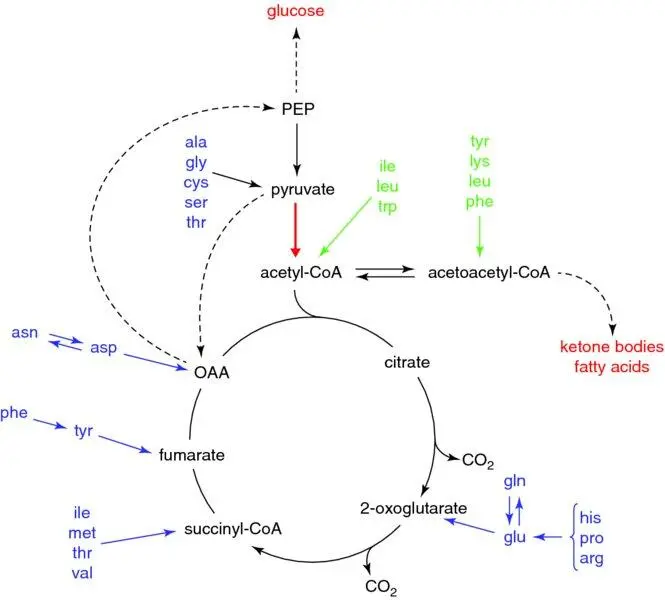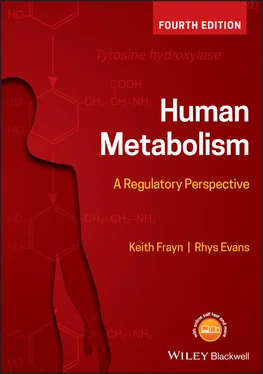The urea cycle starts by forming carbamoyl phosphate from ammonia by the enzyme carbamoyl phosphate synthase ( Figure 1.22). This is the regulated step of the urea cycle, but since ammonia is so toxic, the entire urea cycle must have a high capacity in order to deal with any sudden influx of ammonia-nitrogen if amino acid deamination is acutely increased. This may occur for example in starvation, when endogenous protein is broken down to yield amino acids for deamination and gluconeogenesis, or following consumption of large amounts of protein in the diet (protein cannot be stored as such and therefore the excess amino acids ingested are converted to more efficient energy storage forms [lipid], again following deamination). The carbamoyl phosphate transfers the nitrogen to ornithine, one of a series of amino acid intermediates found in the urea cycle but not used in protein synthesis. The second nitrogen in the urea molecule is introduced by aspartate from aspartate transaminase (see above). Of note, the urea cycle spans both cytosolic and mitochondrial compartments of the liver cell, as well as being partially present in other tissues (intestine, kidney) – possibly a mechanism to ensure that ornithine is not limiting and always available to accept carbamoyl phosphate (and hence ammonia, which cannot be allowed to accumulate).

Figure 1.22 Urea cycle. One nitrogen atom enters the cycle as an ammonium ion from glutamate dehydrogenase, whilst another enters from the amino acid aspartate, itself derived principally from glutamate via a transamination reaction. Hence the urea molecule contains two nitrogen atoms for only one carbon atom. The entire cycle is found only in liver, but sections of the cycle are present in other tissues, notably the intestine and kidney.
Besides urea formation, another route of nitrogen-ammonia excretion exists. In peripheral tissues (e.g. muscle) ammonia may be formed by the oxidative deamination of glutamate (by glutamate dehydrogenase, Box 1.8). This reaction, in combination with the aminotransferases, can be seen to capture amino nitrogen from a number of amino acids. However, blood ammonia concentrations are very low (it is highly toxic) and instead it is exported by being fixed in the amido (side chain) group of glutamine by the enzyme glutamine synthase: hence glutamine is ‘safely’ carrying two nitrogen atoms. In liver, the enzyme glutaminase removes the amido nitrogen of glutamine as ammonia for rapid incorporation into urea (an example of hydrolytic deamination: see Box 1.8). In kidney, glutaminase also removes the amido group of glutamine to form ammonia (and glutamate; glutamate dehydrogenase then deaminates this to form a second ammonia molecule), but here in the kidney the resulting ammonia is excreted directly into the urine where is acts as a urinary buffer (this means that the urine can be buffered without carbon loss). There is also a supply of ammonia from the small intestine (see Chapter 5, Section 5.8). These relationships are discussed further in Chapter 7(Section 7.4).
1.3.4.3 Metabolism of the carbon skeleton
Following deamination, the remaining carbon skeleton enters the common metabolic pool; its fate depends on where it enters this pool of intermediary metabolites. All amino acid carbon skeletons ultimately yield just seven products of intermediary metabolism: pyruvate, 2-oxoglutarate (α-ketoglutarate), succinyl-CoA, fumarate, oxaloacetate, acetyl-CoA and acetoacetyl-CoA. The first five of these represent ≥ 3 carbons, hence amino acids producing these metabolites can be used for glucose synthesis (‘glucogenic’): it is this property that confers on proteins the ability to act as a carbohydrate reserve. The acetyl-CoA and acetoacetyl-CoA, however, yield two (or the equivalent to two) carbons, and amino acids which produce them cannot be used for gluconeogenesis (since PDH cannot be reversed (see Section 1.3.1.3 above) – they can only be oxidised directly in the TCA cycle, undergo lipogenesis or be used to synthesise ketone bodies (‘ketogenic’). This is illustrated in Figure 1.23).

Figure 1.23 Metabolism of the carbon skeletons of amino acids following their deamination. Following deamination, the remaining 2-oxoacid (carbon skeleton) enters intermediary metabolism in one of only seven sites. Glucogenic amino acids are shown in blue, ketogenic amino acids in green.
Supplementary resources related to this chapter, including further reading and multiple choice questions, can be found on the companion website at www.wiley.com/go/frayn.
1 Two important exceptions are mature white adipose tissue, in which triacylglycerol is the major constituent by weight, and the brain, of which 50–60% of dry weight is lipid (mostly phospholipid).
Конец ознакомительного фрагмента.
Текст предоставлен ООО «ЛитРес».
Прочитайте эту книгу целиком, на ЛитРес.
Безопасно оплатить книгу можно банковской картой Visa, MasterCard, Maestro, со счета мобильного телефона, с платежного терминала, в салоне МТС или Связной, через PayPal, WebMoney, Яндекс.Деньги, QIWI Кошелек, бонусными картами или другим удобным Вам способом.














